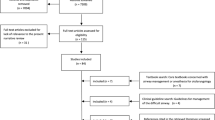Abstract
To emphasize the need for high clinical suspicion in the diagnosis of Laryngeal cleft in paediatric population, to catalogue the pattern of presentation, time to treatment and the evolution of surgical techniques for Laryngeal cleft repair at our center. A retrospective review of laryngeal cleft cases which presented over a period of 8 years (May 2012–May 2020), from a tertiary care center, was done. Data includes—patient demographics, preliminary investigations, diagnostic methods, type of cleft, surgical steps and post-operative follow up. Extensive literature search was done and we could not find similar studies from South East Asia and the Indian subcontinents. Of the 10 patients 7 were managed surgically and 3 conservatively. There was an equal distribution of type 1 (n = 5) and 2 (n = 5) clefts. 80% cases were males and 9 out of 10 patients had associated congenital anomalies. 80% cases had symptom resolution (75% were managed surgically and 25% managed medically). Surgical intervention should be based on the extent of anatomical defect and the functional impairment caused by cleft such as respiratory problems, persistence of feeding issues despite maximal medical management and feeding therapy. Early surgical management of type I and II clefts have satisfactory outcomes.



Similar content being viewed by others
Abbreviations
- LC:
-
Laryngeal cleft
- FEES:
-
Fiber-optic endoscopic evaluation of swallowing
- TE:
-
Tracheo esophageal
- TEF:
-
Tracheaesophageal fistula
- MBS:
-
Modified barium swallow
- DL:
-
Direct laryngoscopy
- GA:
-
General anesthesia
- OGT:
-
Orogastric tube
- LRTI:
-
Lower respiratory tract infection
- yrs:
-
Years
- IA:
-
Inter arytenoid
- pre op:
-
Preoperative
- post op:
-
Post operative
- CXR:
-
Chest X ray
- ETT:
-
Endotracheal tube
- PDS:
-
Polydioxanone suture
- POD:
-
Postoperative day
- TORS:
-
Trans oral robotic surgery
- fig:
-
Figure
- PICU:
-
Paediatric intensive care unit
References
Chitkara AE, Tadros M, Kim HJ, Harley EH (2003) Complete laryngotracheoesophageal cleft: complicated management issues. Laryngoscope 113:1314–1320
Pezzettigotta SM, Leboulanger N, Roger G, Denoyelle F, Garabédian EN (2008) Laryngeal cleft. Otolaryngol Clin North Am 41(5):913–ix. https://doi.org/10.1016/j.otc.2008.04.010
Roth B, Rose KG, Benz-Bohm G, Gunther H (1983) Laryngotracheoesophageal cleft: clinical features, diagnosis and therapy. Eur J Pediatr 140:41–46
Chien W, Ashland J, Haver K, Hardy SC, Curren P, Hartnick CJ (2006) Type 1 laryngeal cleft: establishing a functional diagnostic and management algorithm. Int J Pediatr Otorhinolaryngol 70(12):2073–2079
Rahbar R, Chen JL, Rosen RL et al (2009) Endoscopic repair of laryngeal cleft type I and type II: When and why? Laryngoscope 119(9):1797–1802
Loh R, Phua M, Shaw L (2019) Diagnosis and management of type 1 laryngeal cleft: systematic review Aust J Otolaryngol 2:5
Benjamin B, Inglis A (1989) Minor congenital laryngeal clefts: diagnosis and classification. Ann Otol Rhinol Laryngol 98(6):417–420
Moungthong G, Holinger LD (1997) Laryngotracheoesophageal clefts. Ann Otol Rhinol Laryngol 106(12):1002–1011
Sandu K, Monnier P (2006) Endoscopic laryngotracheal cleft repair without tracheotomy or intubation. Laryngoscope 116(4):630–634. https://doi.org/10.1097/01.mlg.0000200794.78614.87
Yeung JC, Balakrishnan K, Cheng ATL et al (2017) International pediatric otolaryngology group: consensus guidelines on the diagnosis and management of type I laryngeal clefts. Int J Pediatr Otorhinolaryngol 101:51–56
Johnston DR, Watters K, Ferrari LR, Rahbar R (2014) Laryngeal cleft: evaluation and management. Int J Pediatr Otorhinolaryngol 78(6):905–911
Saxena RC, Scott AR (2015) The varying presentations of type I laryngeal cleft: illustrative cases in a set of triplets. Int J Pediatr Otorhinolaryngol 79(4):620–622
Chiang T, McConnell B, Ruiz AG, DeBoer EM, Prager JD (2014) Surgical management of type I and II laryngeal cleft in the pediatric population. Int J Pediatr Otorhinolaryngol 78(12):2244–2249
Andrieu-Guitrancourt J, Borde J, Mitrofanof P, Ensel J, Dehesdin D (1982) Association of posterior laryngeal cleft and atresia of the oesophagus. Two cases treated successfully (author’s transl). Chir Pediatr 23(2):75–80
Rahbar R, Rouillon I, Roger G et al (2006) The presentation and management of laryngeal cleft: a 10-year experience. Arch Otolaryngol Head Neck Surg 132(12):1335–1341
Myer III CM, Cotton RT, Holmes DK et al (1990) Laryngeal and laryngotracheoesophageal clefts: role of early surgical repair. Ann Otol Rhinol Laryngol 99(2pt):98–104
Bowe SN, Hartnick CJ (2017) Management of type I and type II laryngeal clefts: controversies and evidence. Curr Opin Otolaryngol Head Neck Surg 25(6):506–513
Day KE, Smith NJ, Kulbersh BD (2016) Early surgical intervention in type I laryngeal cleft. Int J Pediatr Otorhinolaryngol 90:236–240
Cole E, Dreyzin A, Shaffer AD, Tobey ABJ, Chi DH, Tarchichi T (2018) Outcomes and swallowing evaluations after injection laryngoplasty for type I laryngeal cleft: Does age matter? Int J Pediatr Otorhinolaryngol 115:10–18
Leonardis RL, Duvvuri U, Mehta D (2014) Transoral robotic-assisted laryngeal cleft repair in the pediatric patient. Laryngoscope 124(9):2167–2169
Waltzman M, Bent III J (2001) Repair of type 1-A and 1-B posterior laryngeal clefts. Oper Tech Otolaryngol Head Neck Surg 12(4);252–255
Miller AL, Hersh CJ, Johnson KE, Hartnick CJ (2019) Short-term swallowing outcomes following type 1 laryngeal cleft injection. Int J Pediatr Otorhinolaryngol 116:159–163
Leishman C, Monnier P, Jaquet Y (2014) Endoscopic repair of laryngotracheoesophageal clefts: experience in 17 cases. Int J Pediatr Otorhinolaryngol 78(2):227–231
Strychowsky JE, Dodrill P, Moritz E, Perez J, Rahbar R (2016) Swallowing dysfunction among patients with laryngeal cleft: More than just aspiration? Int J Pediatr Otorhinolaryngol 82:38–42
Author information
Authors and Affiliations
Contributions
All authors contributed to the study conception and design. Material preparation, data collection and analysis were performed by RE, EVR and DS. The first draft of the manuscript was written by RE and all authors commented on previous versions of the manuscript. All authors read and approved the final manuscript.
Corresponding author
Additional information
Publisher's Note
Springer Nature remains neutral with regard to jurisdictional claims in published maps and institutional affiliations.
Rights and permissions
About this article
Cite this article
Emmanuel, R., Raman, E.V. & Shivnani, D. Endoscopic Repair of Laryngeal Clefts: 8 Years’ Experience. Indian J Otolaryngol Head Neck Surg 74, 296–304 (2022). https://doi.org/10.1007/s12070-021-02479-y
Received:
Accepted:
Published:
Issue Date:
DOI: https://doi.org/10.1007/s12070-021-02479-y



